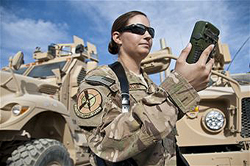 One of 12 magnetograms recorded at Greenwich Observatory during the Great Geomagnetic Storm of 1859
One of 12 magnetograms recorded at Greenwich Observatory during the Great Geomagnetic Storm of 1859 1996 soccer game in the Midwest, (Rick Dikeman image)
1996 soccer game in the Midwest, (Rick Dikeman image)
 Nouméa ground station after the flood
Nouméa ground station after the flood A pencil and a coffee cup show the size of NASA’s teeny tiny PhoneSat
A pencil and a coffee cup show the size of NASA’s teeny tiny PhoneSat Bonus Hotspot: Naro Tartaruga AUV
Bonus Hotspot: Naro Tartaruga AUV
 Pacific lamprey spawning (photo by Jeremy Monroe, Fresh Waters Illustrated)
Pacific lamprey spawning (photo by Jeremy Monroe, Fresh Waters Illustrated) “Return of the Bucentaurn to the Molo on Ascension Day”, by (Giovanni Antonio Canal) Canaletto
“Return of the Bucentaurn to the Molo on Ascension Day”, by (Giovanni Antonio Canal) Canaletto The U.S. Naval Observatory Alternate Master Clock at 2nd Space Operations Squadron, Schriever AFB in Colorado. This photo was taken in January, 2006 during the addition of a leap second. The USNO master clocks control GPS timing. They are accurate to within one second every 20 million years (Satellites are so picky! Humans, on the other hand, just want to know if we’re too late for lunch) USAF photo by A1C Jason Ridder.
The U.S. Naval Observatory Alternate Master Clock at 2nd Space Operations Squadron, Schriever AFB in Colorado. This photo was taken in January, 2006 during the addition of a leap second. The USNO master clocks control GPS timing. They are accurate to within one second every 20 million years (Satellites are so picky! Humans, on the other hand, just want to know if we’re too late for lunch) USAF photo by A1C Jason Ridder.  Detail of Compass/ BeiDou2 system diagram
Detail of Compass/ BeiDou2 system diagram Hotspot 6: Beluga A300 600ST
Hotspot 6: Beluga A300 600ST

1. HERE KITTY, KITTY
Nassau County,New York USA
√ IEEE Spectrum blogger Mark Spezio attached a GPS logger to his wandering cat, whose complex journeys centered on a mouse-hunting paradise: Nassau County Storm Water Basin Storage Area. The cat was amazed to see Mark show up at his secret hideaway.
See cat and maps here
1. HERE KITTY, KITTY
Nassau County,New York USA
√ IEEE Spectrum blogger Mark Spezio attached a GPS logger to his wandering cat, whose complex journeys centered on a mouse-hunting paradise: Nassau County Storm Water Basin Storage Area. The cat was amazed to see Mark show up at his secret hideaway.
See cat and maps here
2. SUMMER SCHOOL
Slettestrand, Denmark
√ The fourth International Summer School on GNSS has a new location and two new lead sponsors: the European Space Agency and Nokia. It will take place at the Danish GPS Center in Slettestrand, Denmark from September 1–11 and welcomes graduate students, post docs and young professionals.
Limited to 50 students — register soon
3. GNSS for Africa
Trieste, Italy and Abuja, Nigeria
√ Sixty African scientists and engineers from 15 nations met in April in Trieste with European and American GNSS experts to help them jump-start college courses and research programs. The goal: new space-based technology for farming, tracking, monitoring and mapping. Boston University scientist Pat Doherty says that they’ll do the Institute of Navigation–sponsored event again in 2011 in Abuja, Nigeria.
4. LET’S MAKE A DEAL
Kiev/Kyiv, Ukraine
√ Ukraine, with its loyalties split between Europe and Russia, tilted further east with a GLONASS cooperation agreement on May 17. Ukraine ground stations will participate in satellite communications and monitoring and the countries will jointly develop new satnav user equipment. They will “synchronize [some] military technology standards and broaden defense cooperation,” says the Geopolitical Monitor, a “web-based open source intelligence collection and forecasting service.”
5. STORMY WEATHER
√ A solar storm is the prime suspect in April’s loss of control over an Intelsat GEO carrying a GPS Wide Area Augmentation System (WAAS) transponder. Luckily, a number of solar studies are underway now — including NASA’s solar observatory (SDO), which will carry out three experiments this year on the sun’s activity and its effect on space weather.





